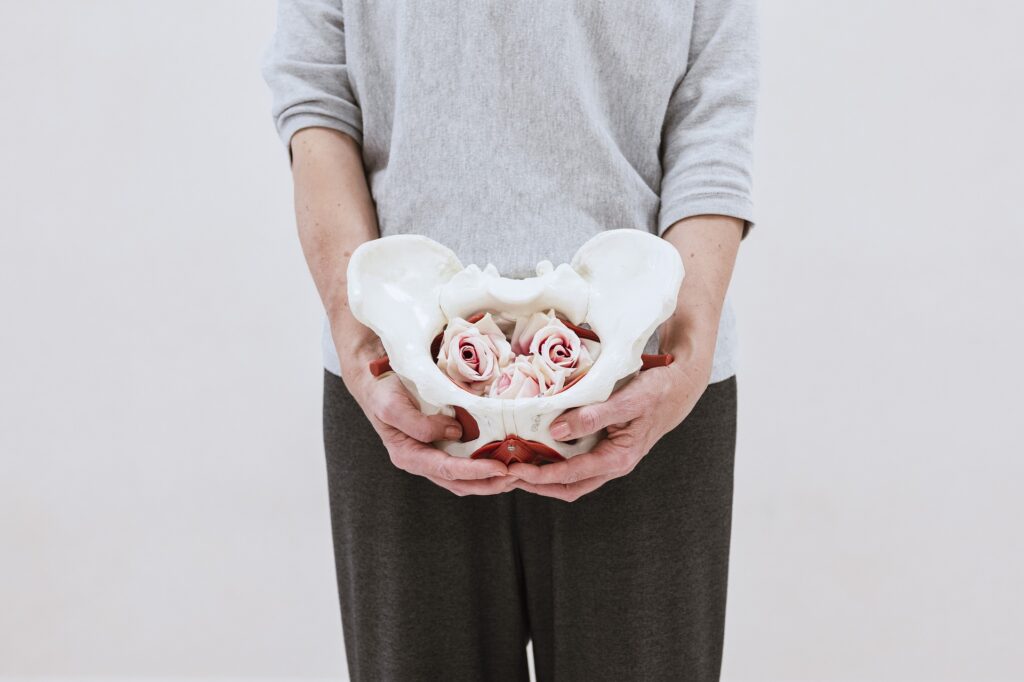When the pelvic organs—such as the uterus, bladder, or rectum—descend and bulge into the vaginal wall, it can lead to various discomforts, including urinary, bowel, and sexual dysfunction. Thankfully, there are several treatment options available to manage POP, and one such approach is the use of pessaries. We will explore below the use of pessaries, their benefits, types, fitting, care, and the role they play in providing support and relief for women dealing with pelvic organ prolapse.
Understanding Pelvic Organ Prolapse
Before delving into the topic of pessaries, it’s crucial to grasp the nature of pelvic organ prolapse. POP occurs when the supportive structures of the pelvis weaken, allowing the pelvic organs to descend into the vaginal canal. The severity of POP can vary, with some women experiencing mild symptoms and others enduring significant discomfort and distress.
Most common symptoms of pelvic organ prolapse include:

- Vaginal bulging or pressure
- Urinary incontinence or retention
- Bowel issues, like constipation or fecal incontinence
- Pain or discomfort during intercourse
- Lower back pain
- A feeling of fullness or something falling out of the vagina
The impact of these symptoms on a woman’s quality of life can be substantial, and this is where pessaries come into play.
What Are Pessaries?
Pessaries are medical devices designed to provide mechanical support to the pelvic organs and the vaginal wall. They come in various shapes and sizes and are typically made of medical-grade silicone. Pessaries are inserted into the vaginal canal, where they provide support to the pelvic organs, helping to alleviate the symptoms of prolapse. They are a non-surgical option and can be considered both a treatment and a management strategy for pelvic organ prolapse.
The Benefits of Using Pessaries
The use of pessaries offers several benefits for women dealing with pelvic organ prolapse:
- Non-Surgical Approach: Pessaries provide a non-invasive alternative to surgery, making them an attractive option for women who wish to avoid or delay surgical intervention.
- Symptom Relief: Pessaries can effectively alleviate the symptoms associated with prolapse, such as vaginal bulging, urinary incontinence, and discomfort during intercourse.
- Customizable Fit: Pessaries come in various shapes and sizes, allowing for a personalized fit that can be adjusted to meet the needs of each individual patient.
- Reversible: The use of pessaries is reversible; they can be removed at any time if desired or if they are no longer needed.
- Preservation of Fertility: Pessaries are an excellent option for women who wish to maintain their fertility and reproductive options (aka not removing the uterus).
- Management of Recurrent Prolapse: For women who have experienced recurrent prolapse following surgical repair, pessaries can be a valuable tool for symptom management.
- Postpartum Support: Pessaries can be used in the postpartum period to provide support as the body heals, and may prevent or alleviate prolapse symptoms during recovery.
Types of Pessaries
Pessaries come in various shapes and sizes, each designed to address different types and stages of pelvic organ prolapse. The most common types include:

- Ring Pessary: A circular pessary, often used for mild to moderate prolapse. It provides support by holding the vaginal walls together.
- Gellhorn Pessary: A solid, teardrop-shaped pessary that is effective for moderate to severe prolapse. It requires proper fitting by a healthcare provider.
- Cube Pessary: This cube-shaped pessary is often recommended for advanced prolapse and is suitable for women with wide vaginal canals.
- Donut Pessary: Designed like a doughnut, this pessary is used to manage prolapse or support surgical repair.
- Inflatable Pessary: This type can be inflated or deflated to adjust its size and fit. It’s versatile and suitable for different stages of prolapse.
The choice of pessary type depends on the patient’s specific condition and the recommendation of a healthcare provider. More shapes, sizes, and materials are on the market. We will elaborate on them in a different blog post.
Pessary Fitting
A proper pessary fitting is crucial to ensure the device works effectively and remains comfortable for the patient. The fitting process typically involves the following steps:
- Assessment: An experienced healthcare provider will assess your condition and determine the appropriate type and size of pessary. This might include testing various types of pessary in one or more sessions.
- Insertion: The pessary is inserted into the vaginal canal. It should fit comfortably and snugly. You should not feel it.
- Adjustment: Some pessaries can be adjusted to ensure the best fit. Sometimes the same type but a size smaller or bigger is required. The healthcare provider will make any necessary modifications.
- Testing: With the best fit, its time to test the pessary in real world situations. You should take a walk, climb stairs, use the bathroom, squat, jump, stretch, sit…Only if you feel comfortable in various situations, its the right pessary for you.
- Education: Women are provided with instructions on how to care for and clean the pessary, how to remove and reinsert it if necessary, and when to schedule follow-up appointments.
Regular follow-up appointments are essential to monitor the pessary’s condition and fit. Adjustments may be needed over time as the pelvic floor muscles and the vaginal canal change. You might need a different size or type pessary after a few months of physical therapy or after an additional pregnancy.
Caring for Your Pessary
Proper care and maintenance of the pessary are crucial for its effectiveness and longevity. Here are some key care guidelines:

- Cleaning: Wash the pessary daily with mild soap and warm water, and rinse thoroughly. It’s essential to keep it clean to prevent infection. If you don’t take it out daily, wait for your appointment with your health care provider.
- Removal and Reinsertion: In some cases, you may be instructed to remove the pessary at night or during specific times to allow the vaginal tissue to breathe. It’s important that your health care provider showed you how to remove and insert your pessary. With time and practice it will get easier and faster.
- Regular Follow-Up: Attend regular follow-up appointments with your healthcare provider to ensure the pessary continues to fit properly and remains effective. Especially if your symptoms change without any apparent reason.
- Replacement: Pessaries have a lifespan, and they may need replacement if they become worn or damaged. A good starting point is the manufacturers information provided with your pessary. Most silicone pessaries can be worn 12 months (if properly taken care of) before a replacement is required.
- Communication: If you experience any discomfort, pain, or unusual discharge while using a pessary, contact your healthcare provider promptly. Don’t wait and suffer in silence.
The care guidelines may vary based on the type of pessary you have. Stay tuned for a more in-depth guide on caring for different kinds of pessaries.
Pessaries offer an effective, non-surgical option for managing and alleviating the symptoms associated with prolapse. Their customizable fit, reversible nature, and ability to preserve fertility make them a valuable tool in the management of this condition.
The use of pessaries should be carried out under the guidance of a knowledgeable healthcare provider who can determine the appropriate type and fit for each individual patient. Proper care, regular follow-up, and communication with your healthcare team are essential for ensuring the continued effectiveness and comfort of the pessary. By providing support and symptom relief, pessaries empower women to regain control of their lives and alleviate the distressing symptoms of pelvic organ prolapse. They offer hope and an improved quality of life.
